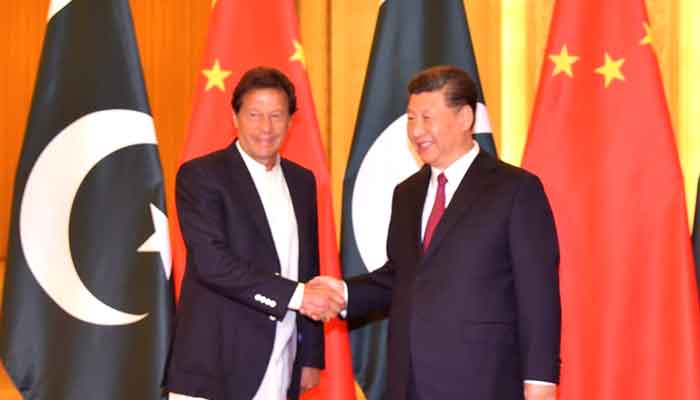Free trade with China: Pak industry protected, cabinet told
“The major protected industry includes textiles and clothing, iron and steel, auto, electrical equipment, agriculture, chemicals, plastics, rubber, paper and paper board, ceramics, glass and glassware, surgical instruments, footwear, leather, wood, articles of stones and plaster and miscellaneous goods. “In a nutshell, we have protected almost all of our industry,” a brief of the Ministry of Commerce states.
ISLAMABAD: Pakistan’s trade managers on Tuesday informed the federal cabinet that the protected list of items under the second phase of China Pakistan Free Trade Agreement (CPFTA) has gone up to 1,760 tariff lines or 25 percent of total imports on account of sensitive list and margin of preference.
- Pakistan's List of 313 High Priority Tariff lines to get Immediate Tariff Elimination from China
- Pakistan's Sensitive List Under CPFTA Phase II
- List of items given 20% MOP
- Anticipated Gains from CPFTA Phase II
However, it will remain the biggest challenge for the government to curtail the yawning trade deficit with China that had already ballooned to $15 billion. But this import largely related to fertilisers, raw material, bulbs, laptops and such items. Pakistan’s exports to China are showing dismal performance and Adviser to PM on Commerce Abdul Razak Dawood estimated before hisdeparture to Beijing that Pakistan’s exports could go up by $500 million in first year. However, the sources pointed out that there was no need to expect additional exports of $500 million, but diversion in exports could happen at initial stage, but then the exporters could generate surplus to grab this opportunity at later stages.
There has been an increase in the protected list of Pakistan from 10 percent in phase- I of CPFTA to now 25 percent into phase-II that comes to around 1,760 tariff lines and covers 37 percent of Pakistan’s imports from China. It includes 25 percent sensitive list of 1,410 items (20 percent) and a list of 350 items given margin of preference (MoP) on the applicable rates (5 percent).
“The major protected industry includes textiles and clothing, iron and steel, auto, electrical equipment, agriculture, chemicals, plastics, rubber, paper and paper board, ceramics, glass and glassware, surgical instruments, footwear, leather, wood, articles of stones and plaster and miscellaneous goods. “In a nutshell, we have protected almost all of our industry,” a brief of the Ministry of Commerce states.
In the Phase I, Pakistan had already given substantial concessions on 60 percent of imports from China, and with this new phase in place, Pakistan will liberalise another 7 percent in the next 15 years. Most of concessions have been placed in the 15 years track. The 7 percent new liberalised trade constitutes raw materials, machinery and intermediate items which will in fact help the domestic industry to become more competitive.
China will be immediately eliminating tariffs on 313 most priority tariff lines which cover over $8.7 billion worth of our global exports and $64 billion worth of Chinese global imports.
Whereas, under the complete offer from China, over $19 billion of our exports will be covered corresponding to $1.6 trillion of the Chinese global imports. Under the 313 tariff lines, currently our exports to China are less than 2 percent of their total imports, and with these concessions we should expect to gain our market share by at least 10 percent which will come around $6.5 billion per annum.
The 313 tariff lines constitute textiles and garments, seafood, meat and other animal products, prepared foods, leather, chemicals, plastics, oil seeds, footwear as well as engineering goods including tractors, auto parts, home appliances, machineries etc.
With the signing of this FTA, almost 95 percent of tariff lines will become part of the overall CPFTA framework and will therefore enable electronic data exchange on these tariff lines which also constitute 95 percent of the imports from China. Therefore, this will be great step forward in terms of curbing under invoicing and misclassification.
The revision of safeguard remedial measures will provide protection of maximum 23 years against an imports surge that may cause injury or threatens to cause injury to our local industry. The measures also allow Pakistan to put in place provisional safeguards for 180 days before even proving the injury or the threat to the injury.
Similarly, the safety valve of the balance of payments clause under the FTA has been introduced which would now allow Pakistan to raise tariffs if the country is in a balance of payments difficulty.
A Balance of Payment Clause has been included in the agreement to address any balance of payment difficulty, which was amiss in the first phase. In order to address under-invoicing and mis-declaration, system of electronic data exchange has been agreed between the two sides and implemented.
• During the 11th Round held in April 2019, China agreed to immediately eliminating tariffs on 313 most priority tariff lines of Pakistan which cover over $8.7 billion worth of Pakistan’ global exports (13% increase in Pakistan’s global exports coverage) and $64 billion worth of Chinese global imports (additional $40 billion).
• Under the complete offer from China, over $19 billion of Pakistan, exports will be covered corresponding to $1.6 trillion of the China’s global imports.
• The 313 tariff lines constitute: textiles and garments, seafood, meat, animal products, prepared foods, leather, chemicals, plastics, footwear, engineering goods including tractors, auto parts, home appliances, machineries etc.
All major agriculture products and processed food important from local production and food security point of view have been protected.
During all rounds of negotiations, senior representatives of the FBR, EDB, Ministry of Textile, NTC and Food Security were present and were taken on board.
-
 Katie Bates Husband Travis Clark Confesses He Cheated On Her
Katie Bates Husband Travis Clark Confesses He Cheated On Her -
 Andrew Makes Life As Newly Stripped Commoner Offensive To The People
Andrew Makes Life As Newly Stripped Commoner Offensive To The People -
 Kansas Woman Loses $255,000 In Gold In FBI Impersonation Scam
Kansas Woman Loses $255,000 In Gold In FBI Impersonation Scam -
 Prince Harry Arrives In UK To Fight His Phone Hacking Case
Prince Harry Arrives In UK To Fight His Phone Hacking Case -
 Nick Jonas Attempts To Take Break From Jonas Brothers With Upcoming Solo Album?
Nick Jonas Attempts To Take Break From Jonas Brothers With Upcoming Solo Album? -
 Hayden Panettiere Gets Candid About Putting Life Story On Paper
Hayden Panettiere Gets Candid About Putting Life Story On Paper -
 'Ted Lasso' Star Reveals Real Wish For Season Four Story
'Ted Lasso' Star Reveals Real Wish For Season Four Story -
 Peter Claffey 'just Hoping' For THIS Ahead Of 'Game Of Thrones' Spinoffa
Peter Claffey 'just Hoping' For THIS Ahead Of 'Game Of Thrones' Spinoffa -
 Sophie Turner Reflects On Life After Motherhood: 'Really Nice'
Sophie Turner Reflects On Life After Motherhood: 'Really Nice' -
 Royal Expert Makes Bombshell Claim On How Late Queen Tried To Protect Andrew
Royal Expert Makes Bombshell Claim On How Late Queen Tried To Protect Andrew -
 81-year-old Florida Woman Arrested After Chilling Murder Plot
81-year-old Florida Woman Arrested After Chilling Murder Plot -
 Cardi B Scores Major Earn Against Offset In Legal Battle
Cardi B Scores Major Earn Against Offset In Legal Battle -
 Bella Hadid Gets Honest About Receiving Support From 'The Beauty' Co-stars
Bella Hadid Gets Honest About Receiving Support From 'The Beauty' Co-stars -
 Nobel Foundation Reaffirms Its Core Responsibility To ‘safeguard The Dignity Of The Nobel Prizes’
Nobel Foundation Reaffirms Its Core Responsibility To ‘safeguard The Dignity Of The Nobel Prizes’ -
 Prince William, Kate Middleton Warned Of Meghan Markle’s UK Return
Prince William, Kate Middleton Warned Of Meghan Markle’s UK Return -
 Melissa Leo Reveals How Winning An Oscar Made Things Worse
Melissa Leo Reveals How Winning An Oscar Made Things Worse




